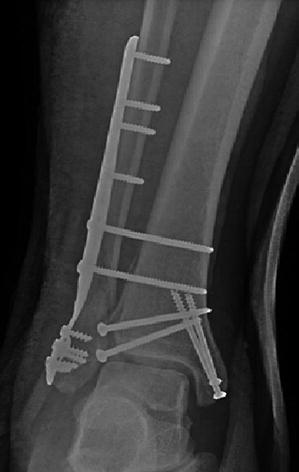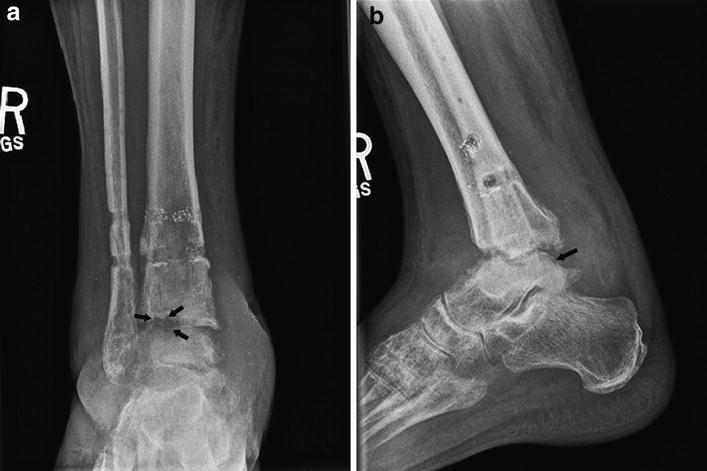Fig. 1
(a and b) Injury radiographs

Fig. 2
Initial internal fixation radiograph

Fig. 3
(a and b) Twenty-one months postfracture, note tibiotalar erosion. Patient had previous hardware removal, repeat I & D, cultures + for MSSA, IV antibiotics for 6 weeks. Continued to have pain and signs of talar erosion 1 month after previous I & D
3 Preoperative Problem List
Osteomyelitis of tibia, fibula, and talus
Arthritis of ankle joint
Chronic pain
Deep venous thrombosis
Lupus anticoagulant disorder
Depression
Pulmonary embolism
4 Treatment Strategy
The patient required a stepwise approach to fracture healing, eradication of infection, and limb salvage. Fracture healing was achieved first, despite noted soft tissue infection (cellulitis) during initial healing period. Retention of hardware and empiric administration of oral antibiotics allowed continued stabilization of the fracture during the initial healing phase. After the fracture healed, treatment of residual infection was pursued by repeat I & D procedures and local biodegradable depot antibiotics to clear the infection from the ischemic local tissue area. The ankle joint remained painful due to postinfectious and post-traumatic arthritis, so he elected fusion for limb salvage versus amputation. The Ilizarov frame was used to compress and promote fusion of the ankle.
Even after the joint was fused and the frame removed, the patient again had to be treated for a flare of his infection with a repeat I & D with cultures and local antibiotic delivered by CaSO4 and IV antibiotics with eventual success.
5 Basic Principles
Cierny–Mader staging is used to direct the principles of treatment of osteomyelitis .
Patient selection is defined by the physiologic status of the host, ranging from A, healthy with normal healing ability, to B which is compromised locally (l) and systemically (s) to C which is compromised where the ability to heal is very low; i.e., “the treatment is worse than the disease” (Quote from George Cierny).
The anatomic extent of disease is defined by categories 1–4. 1 is medullary, 2 superficial (i.e., contiguous with skin ulcer or wound), 3 localized (sequestrum), and 4 diffuse (nonunion or joint).
Treatment takes into account both the host classification and extent of disease, looking at the host’s ability to respond to the chosen management option(s). Initial treatment can be used to change the stage of osteomyelitis , such as by debridement procedures, dead space management, stabilization of nonunion or joint destruction with internal or external fixation, and soft tissue flaps. The host status to heal can also be improved with culture-directed antibiotics and optimization of systemic factors such as renal failure, diabetes, cardiac and pulmonary disease, smoking, and drug abuse. This both decreases the bio-burden and improves the host’s ability to respond to physiologic compromise caused by infectious process. The course of therapy is chosen in order to produce improvement in patient’s quality of life without causing overwhelmingly negative effects.
This case is initially stage 4Bls, signifying diffuse osteomyelitis in host type B with local (“l”) compromise, (due to ischemic local tissue because of scarring from his open injury and surgery, scleroderma, and venous stasis due to DVT), and systemic (“s”) compromise, (due to smoking, scleroderma, deep vein thrombosis, and psychological issues), but otherwise good soft tissue and host. Osteomyelitis is stage 4, diffuse. The patient transitions over time and with continuing treatment to become host type A, essentially in good health with minimal comorbidity and good soft tissue envelope. Therapy to “down-stage” (manage and alter the stage) consists of debridement to good bleeding tissue, deep cultures for appropriate antibiotics, dead space management with depot antibiotics, and ultimately reconstruction and limb salvage. The initial large burden of inert material (fracture fixation hardware) was removed, and later burden of arthritis secondary to infection is dealt with in the process (Calhoun et al. 2009).
6 Images During Treatment
See Figs. 4, 5, 6, and 7




Stay updated, free articles. Join our Telegram channel

Full access? Get Clinical Tree








